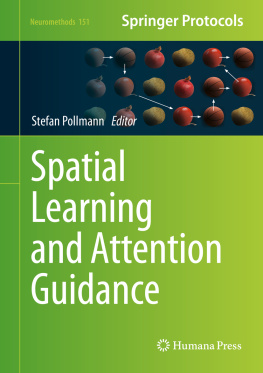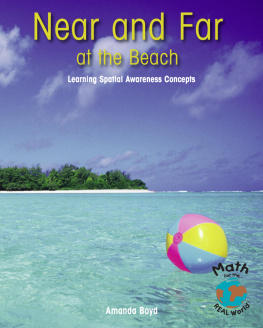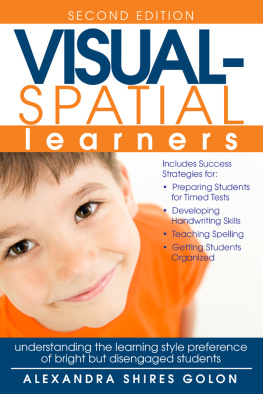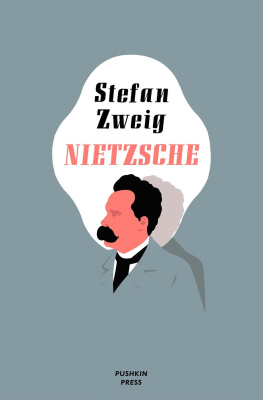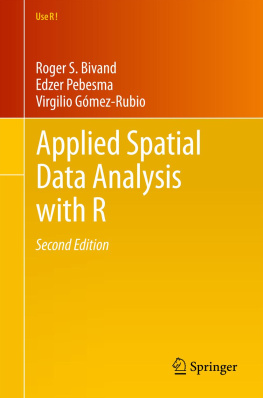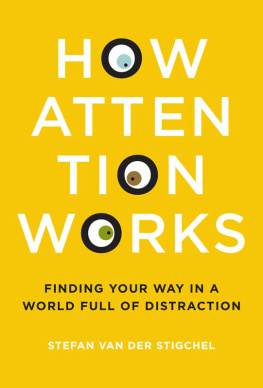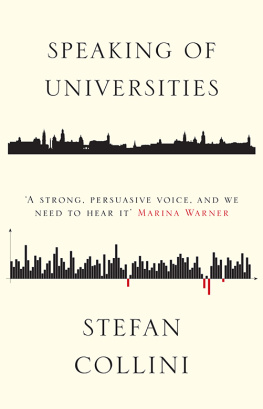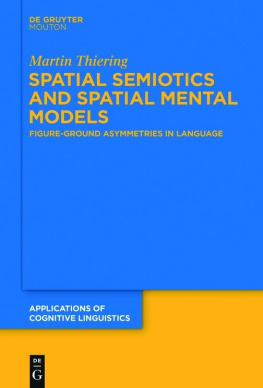Stefan Pollmann - Spatial Learning and Attention Guidance
Here you can read online Stefan Pollmann - Spatial Learning and Attention Guidance full text of the book (entire story) in english for free. Download pdf and epub, get meaning, cover and reviews about this ebook. year: 2020, publisher: Human, genre: Romance novel. Description of the work, (preface) as well as reviews are available. Best literature library LitArk.com created for fans of good reading and offers a wide selection of genres:
Romance novel
Science fiction
Adventure
Detective
Science
History
Home and family
Prose
Art
Politics
Computer
Non-fiction
Religion
Business
Children
Humor
Choose a favorite category and find really read worthwhile books. Enjoy immersion in the world of imagination, feel the emotions of the characters or learn something new for yourself, make an fascinating discovery.
- Book:Spatial Learning and Attention Guidance
- Author:
- Publisher:Human
- Genre:
- Year:2020
- Rating:5 / 5
- Favourites:Add to favourites
- Your mark:
- 100
- 1
- 2
- 3
- 4
- 5
Spatial Learning and Attention Guidance: summary, description and annotation
We offer to read an annotation, description, summary or preface (depends on what the author of the book "Spatial Learning and Attention Guidance" wrote himself). If you haven't found the necessary information about the book — write in the comments, we will try to find it.
Spatial Learning and Attention Guidance — read online for free the complete book (whole text) full work
Below is the text of the book, divided by pages. System saving the place of the last page read, allows you to conveniently read the book "Spatial Learning and Attention Guidance" online for free, without having to search again every time where you left off. Put a bookmark, and you can go to the page where you finished reading at any time.
Font size:
Interval:
Bookmark:
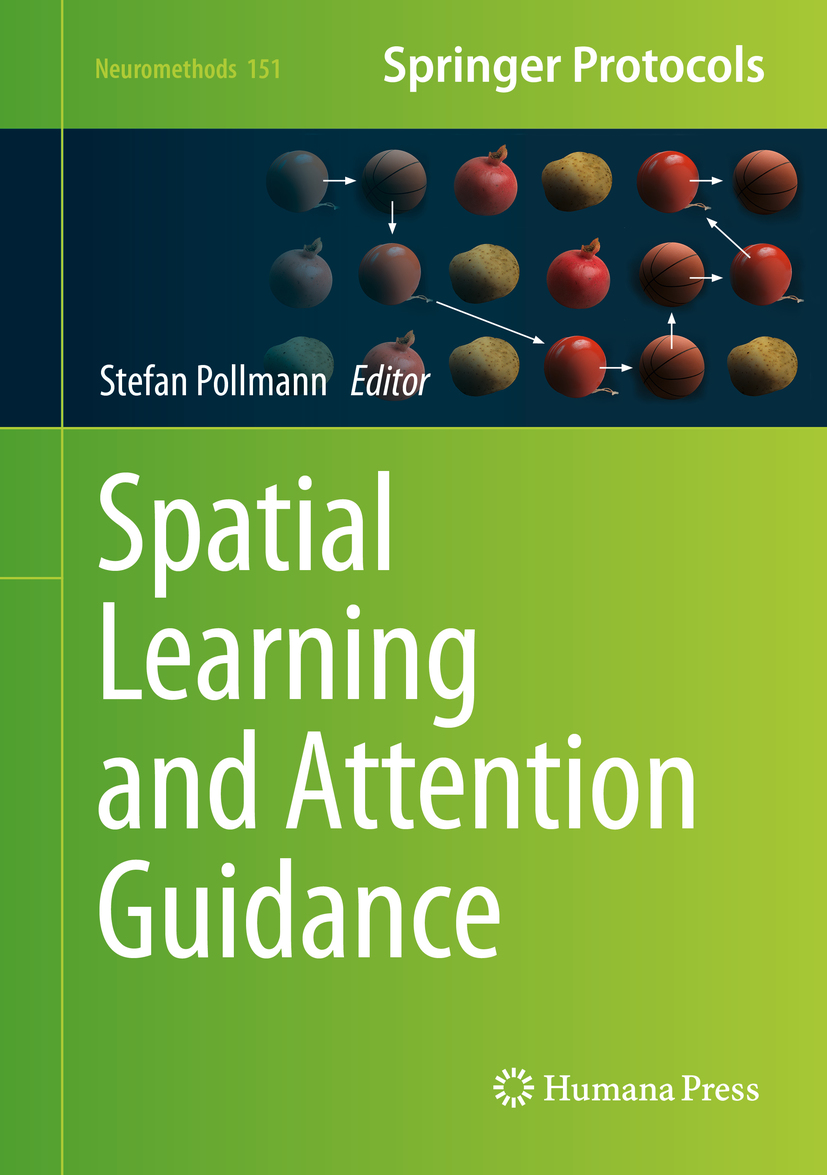
For further volumes: http://www.springer.com/series/7657

This Humana imprint is published by the registered company Springer Science+Business Media, LLC, part of Springer Nature.
The registered company address is: 233 Spring Street, New York, NY 10013, U.S.A.
Experimental life sciences have two basic foundations: concepts and tools. TheNeuromethodsseries focuses on the tools and techniques unique to the investigation of the nervous system and excitable cells. It will not, however, shortchange the concept side of things as care has been taken to integrate these tools within the context of the concepts and questions under investigation. In this way, the series is unique in that it not only collects protocols but also includes theoretical background information and critiques which led to the methods and their development. Thus it gives the reader a better understanding of the origin of the techniques and their potential future development. TheNeuromethodspublishing program strikes a balance between recent and exciting developments like those concerning new animal models of disease, imaging, in vivo methods, and more established techniques, including, for example, immunocytochemistry and electrophysiological technologies. New trainees in neurosciences still need a sound footing in these older methods in order to apply a critical approach to their results.
Under the guidance of its founders, Alan Boulton and Glen Baker, theNeuromethodsseries has been a success since its first volume published through Humana Press in 1985. The series continues to flourish through many changes over the years. It is now published under the umbrella of Springer Protocols. While methods involving brain research have changed a lot since the series started, the publishing environment and technology have changed even more radically. Neuromethods has the distinct layout and style of the Springer Protocols program, designed specifically for readability and ease of reference in a laboratory setting.
The careful application of methods is potentially the most important step in the process of scientific inquiry. In the past, new methodologies led the way in developing new disciplines in the biological and medical sciences. For example, Physiology emerged out of Anatomy in the nineteenth century by harnessing new methods based on the newly discovered phenomenon of electricity. Nowadays, the relationships between disciplines and methods are more complex. Methods are now widely shared between disciplines and research areas. New developments in electronic publishing make it possible for scientists that encounter new methods to quickly find sources of information electronically. The design of individual volumes and chapters in this series takes this new access technology into account. Springer Protocols makes it possible to download single protocols separately. In addition, Springer makes its print-on-demand technology available globally. A print copy can therefore be acquired quickly and for a competitive price anywhere in the world.
Human behavior depends to a large degree on spatial learning. This is obvious when we search for an object, explore a scene or navigate an environment. Research on these topics has asked how visual search can be guided by both short-term and long-term memory, often gained by implicit learning. Recent experiences influence where we look, in the form of priming. However, repeated spatial configurations can also lead to long-lasting improvements of search. What is learned is often of a statistical, probabilistic nature. The search improvements manifest themselves in reduced search times, and also in more efficient gaze paths. Eye movements are important both for encoding environmental aspects into memory and for making use of learned spatial patterns for efficient search. While these processes are mostly implicit, spatial memory is often explicit, e.g., when we hold information in working memory for an ongoing task. Working memory, in turn, interacts with long-term memory and is increasingly seen as an activated part of long-term memory.
The neural code of spatial learning and memory has been intensively investigated in the recent years. In particular, the storage and manipulation of information in working memory are currently an intense focus of research. Novel EEG and MEG analysis methods yield insights in the processes of memory storage, whereas both structural and functional MR methods enable fine-grained analyses of the functional neuroanatomy of spatial learning and memory.
The chapters in this volume treat both well-established andin the majorityvery recent methods. The former have been included because of their widespread use and the latter because of their potential for future use across the field of spatial learning and attention guidance. While some of the methods have been described in dedicated papers, to my knowledge there is no comparable collection of methods in a single volume.
This book is divided into three partsbehavioral, psychophysiological, and functional neuroimaging methods. The chapters in Part I focus on different aspects of visual search. Kristjansson and colleagues discuss visual foraging methods. While classical visual search paradigms are about finding a single target in a search display, visual foraging is about finding many targets in a display or scene. This allows more dynamic search tasks that capture search processes that are not typically seen in classical search tasks. Visual search involves eye movements. The measurement of eye movements has become more and more tractable over the years, so that eye movement recordings are now an important source of data that not only inform us about the total duration of search, like reaction times, but also enable us to investigate attentional strategies that occur during search. Hollingworth and Bahle give an overview of paradigms and methods of eye tracking in visual search. Visual search is affected by priming. Chetverikov and colleagues present a new method to analyze the effects of feature distributions in the search history on the internal representation of visual ensembles. Contextual cueing allows to investigate the impact of implicitly learned spatial contexts on memory-guided search. The chapter by Jiang and Sisk provides a methodological guide on the experimental paradigm of contextual cueing and reviews key findings. In addition, Marek and Pollmann present a virtual reality environment for contextual cueing experiments.
Font size:
Interval:
Bookmark:
Similar books «Spatial Learning and Attention Guidance»
Look at similar books to Spatial Learning and Attention Guidance. We have selected literature similar in name and meaning in the hope of providing readers with more options to find new, interesting, not yet read works.
Discussion, reviews of the book Spatial Learning and Attention Guidance and just readers' own opinions. Leave your comments, write what you think about the work, its meaning or the main characters. Specify what exactly you liked and what you didn't like, and why you think so.

